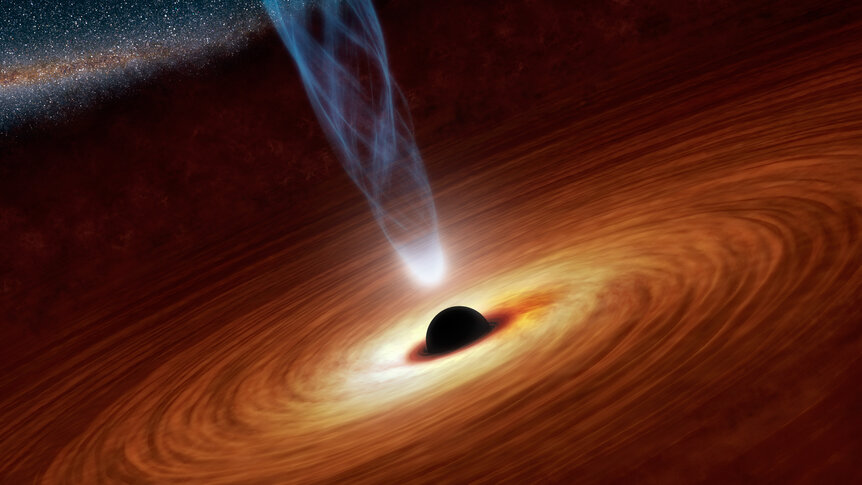Create a free profile to get unlimited access to exclusive videos, sweepstakes, and more!
A distant galaxy's black hole is big, but not big enough

[Image credit: ESA/Hubble & NASA, Acknowledgement: Judy Schmidt]
RX J1140.1+0307 is weird. And not just because of its name*.
As you can see from the Hubble image above, it’s a lovely face-on spiral galaxy. At a billion light-years away, it’s roughly the same size as our Milky Way, making it pretty big, as galaxies go.
When I first saw it, I though it looked a little funny because the bright nucleus is off-center. Then I took a better look; the spiral arms on the right are a little more extended, making the galaxy look asymmetric. But, actually, that isn’t so uncommon in spirals. Maybe it had a close encounter with another galaxy recently, distorting its shape (in the original image, you can see a decent-sized galaxy to the upper right; that may be a total coincidence, though, since that could be a billion light-years farther away in the background).
It turns out RX J1140 is weird for another reason: It’s an active galaxy. Every big galaxy in the Universe has a supermassive black hole in its heart. Sometimes, those black holes are just sitting there, with no material nearby for them to eat. We call those quiescent. Sometimes, though, gas and dust is dropping down into the hole. It piles up in a disk (called an accretion disk), heats up to ridiculously high temperatures -- like millions of degrees ridiculously high -- and blasts out radiation across the electromagnetic spectrum. We call those black holes active.
The black hole at the core of RX J1140 is active. The gas swirling around the black hole emits light we can detect, giving us a nice, indirect measure of the black hole itself.
And that’s where RX J1140 gets really weird: By all accounts, the black hole is too small.
In decent-sized galaxies, the black hole at the center generally has millions or billions of times the mass of the sun. The black hole in the center of our galaxy is equal to four million times the mass of the Sun; the one in the center of our neighboring Andromeda Galaxy is 25 times more massive still. Ours is considered a bit of a lightweight.
But using various methods to determine the heft of the black hole at the core of RX J11140, it appears to be less than a million solar masses. It may not even qualify as “supermassive” at all, but instead be at the high end of what we call intermediate mass black holes (in between supermassive and stellar mass ones, the latter being the kind created when massive stars explode). That’s still huge, but not huge enough; at least not nearly as large as the vast majority of black holes in galactic centers.
And it gets even weirder! There’s a concept called the Eddington Limit that’s important here. The material swirling around the black hole is extremely hot, and blasts out light (this is why we can see active galaxies from billions of light years away; they are among the most luminous objects in the Universe). If they get too hot and too bright, then material has a hard time falling in; the pressure from the light acts like a wind, blowing the material back out again. That’s the Eddington Limit; where radiation pressure outward balances gravity inward.
Measuring the light from RX J1140’s black hole disk, astronomers find it’s actually too bright: It’s glowing at ten times the Eddington Limit for a black hole with such a low mass! At face value, that means nothing should be falling inward. But then, that would mean the black hole has nothing to eat, and it should get dimmer. Paradox.
So, what’s the deal? It’s not clear. It may be that some of the light is blocked by material near the black hole, allowing stuff to fall in closer. Maybe there are strong magnetic fields in the accretion disk (which are known to occur) that keep it stable against the fierce pressure. Maybe it’s something else. It’s a mystery for now.
Mysteries don’t disturb scientists too much, but for some reason a lot of media think the word “mystery” is synonymous with “impossible”. When we find objects like this, it’s distressingly commonplace to see headlines like, “Astronomers find a black hole that defies the laws of physics”. I know that’s meant to draw your attention, but it bugs me. The black holes are doing exactly what they’re supposed to do. It’s we who don’t understand the physics in detail well enough to understand all their behavior.
That may seem trivial, but the distinction is important. The headline implies a weakness in science, like scientists are a group of like-minded automatons who suffer from groupthink and can brook no unexplained behavior.
But the opposite is true. Do you know what the single most powerful word in science is?
“Yet”.
RX J1140 is weird, certainly, and behaves in ways we can’t explain. Yet. Give us time. We’ve only just started figuring the Universe out, and we’ve come a remarkably long way. But there’s no finish line! There’s always more to learn, and as we continue to explore we will continue to increase our understanding. That is the nature of science, and one of its many strengths.
* Most astronomical object names are from their catalog entry, whichever catalog it happens to be. In this case it’s from the ROSAT X-ray catalog of objects —hence the RX— and its coordinates on the sky.



























